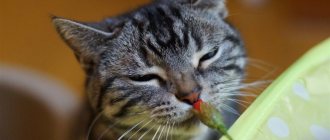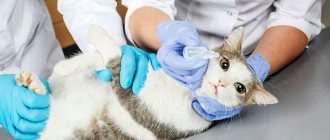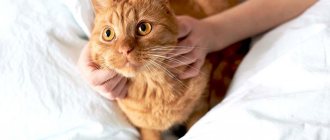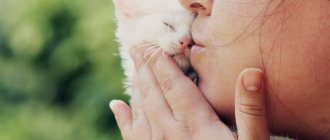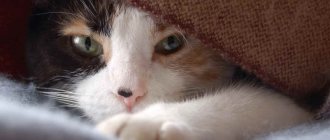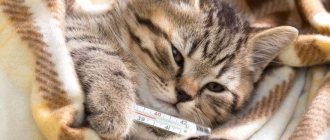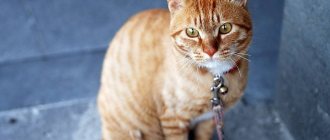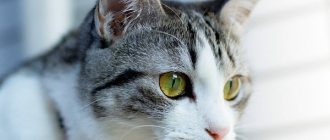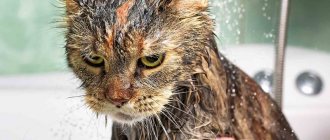13138Administration
1
Many owners often wonder why their cat sneezes and his eyes water. Some consult with a veterinarian, others try to overcome it on their own by washing the eyeball with herbal or tea infusions, while others hope that it will go away on its own.
Often the owner still pays attention to the fact that the animal is sneezing. If it sneezes due to dust particles getting into the nasal passage, then there is no need to worry. But when a runny nose and sneezing become permanent, it is necessary to figure out why the animal is sneezing and eliminate the disease.
Tears in animals perform a protective function, which is similar to the processes occurring in humans. Tears appear if dust or speck gets in. This is normal. But if the cat behaves restlessly and the flow of tears continues for a sufficient time, then this process must be stopped.
© shutterstock
If a cat’s eyes are watery and sneezing at the same time, then these are good reasons to seek help from a doctor.
Causes
What should you do if your cat sneezes and his eyes water?
Watery eyes and sneezing can occur either from ordinary litter or from a serious infection. Therefore, at the first symptoms, it is recommended to see a specialist.
The most common reasons why a cat's eyes are watery are:
Allergy . This phenomenon is quite common. Allergic reactions can be caused by various household products, perfumes, deodorants, pollen, mold, and even cat litter.
It often happens that a baby sneezes on his own fur , which ends up in various organs. Irritation and fluid discharge from the eyes can be caused by blood-sucking insects: mosquitoes and fleas.
In case of allergies, you need to find sources and methods to eliminate them.
- Conjunctivitis . Many bacteria and infections can cause inflammation of the organ mucosa. Conjunctivitis is accompanied by itching, the eyelids become swollen, and pus may drain from the eyes. With complex manifestations of this disease, fever may appear. The cat will be weak. There may also be a lack of appetite.
- Children's age of a cat . Strong production of tears is typical for newborn kittens who have opened their eyes for the first time. Usually the mother cat does the washing. But if she is not nearby, then the kitten’s eyes should be wiped with boiled water or an infusion of weak tea.
- Breed personality . There are special breeds of cats, such as Persians, Britons and Sphynxes, in which lacrimation occurs due to their anatomical shape of the eyes and structure of the skull. Such animals require careful care.
- Weakened immunity . Such cats are more often exposed to diseases and infections. Often with the following symptoms: sneezing, coughing, watery eyes. To strengthen the immune system and to never hear the animal sneeze, you should get special vaccinations and monitor the cat’s diet.
- Infectious diseases . The eyes are watery, the pet is sneezing - all this can occur with the following infections: chlamydia, calcivirosis, rhinotracheitis and others. Some of them are transmitted by airborne droplets, so the owner is at risk of becoming infected. To prevent various infections, as well as to avoid identifying the reasons why your friend is sneezing and his visual organs are watery, it is recommended to vaccinate the animal on time.
- Eye diseases . Of these, glaucoma and cataracts are well known. These are very serious illnesses that appear due to improper metabolism and can lead to loss of vision in a cat. In the early stages, the disease is quite easy to recognize. At a later stage, the cat’s vision decreases, the lens becomes cloudy, and lacrimation appears.
- Helminths . When cats develop worms, vomiting, diarrhea, lack of appetite, and excessive lacrimation are possible.
- Eye damage . If a cat has an injury in the area of these organs and they are tearing a lot, then it is necessary to inspect this area. If the wound is not severe, then simply treating it with Furacilin solution will help. For severe bruises, you should consult a doctor.
How to find out the cause of a cat's sneezing
If your pet is not exposed to external stimuli that cause sneezing, it should be carefully examined for the presence of other symptoms indicating the development of the disease.
Table: diseases accompanied by sneezing
| Disease | Symptoms |
| Infectious diseases |
|
| Helminthiasis | With helminthiasis, sneezing is a consequence of an allergic restructuring of the immune system in response to helminthic infestation; the symptoms are:
|
| Dirofilariasis | Occurs with damage to the chambers of the heart, the following are observed:
|
| Allergic reactions |
|
| Bronchial asthma |
|
| Foreign body in the nasal cavity |
|
| Otitis | Leads to the spread of the infectious process through the Eustachian tube to the mucous membrane of the upper respiratory tract, manifested by:
|
| Sinusitis |
|
| Periodontitis | Causes sinusitis, and is also always accompanied by gingivitis, inflammation of the gums. Manifests:
|
| Polyps | These are growths of the mucous membrane as a result of its prolonged inflammation, they are benign and manifest themselves:
|
| Malignant tumors | Rarely found in older pets. Symptoms:
|
Sneezing is a valuable diagnostic symptom, indicating either the onset of an acute disease or the presence of a hidden pathology, so the attentive owner wins the most valuable thing - time.
Only a veterinarian can determine the cause of sneezing.
When is help needed?
If your animal has the following symptoms, then a trip to the veterinarian is required:
- the cat is constantly sneezing;
- his eyes are watering;
- no appetite;
- irritation and itching in the area of the visual organ;
- purulent discharge;
- the eyes became a different color and became cloudy;
- the animal is very lethargic or, on the contrary, overexcited;
- There are deep wounds and cuts.
The doctor will conduct an examination and prescribe the right treatment, thanks to which you will not hear or see your baby sneezing or his eyeballs watering.
Complications arising from drug-induced rhinitis
The most common adverse effects of rhinitis medicamentosa are:
- persistent swelling of the nasal passages;
- night snoring;
- lack of smell;
- nasal voice;
- headache;
- frequent sneezing and watery eyes;
- feeling of itching, tingling and burning in the nose;
- tissue atrophy;
- dryness and hyperplasia of the mucous membranes;
- nosebleeds;
- displacement of the nasal septum.
In most cases, doctors manage to rid the patient of drug addiction using conservative methods. Surgery is used when treatment is ineffective.
With the help of drugs
When an animal sneezes and its pupils are watery, the doctor suggests treatment with the following means:
- Anandin. This medicine helps in rapid healing of wounds and has antimicrobial effects;
- Maxidin. Has good immunostimulating properties. May help with inflammation of the eyes and rhinitis;
- Thymogen. This is a drug that regulates the immune system.
If no positive trends are observed, then, on the recommendation of a doctor and under his supervision, the following pills should be taken:
- Naphthyzin. It comes in the form of nasal or eye drops. Has the property of constricting blood vessels and has an antiphlogistic effect;
- Dioxidine. It is used for purulent rhinitis and has disinfectant properties;
- Derinat. Helps strengthen the immune system, used mainly for rhinitis and conjunctivitis;
- Nazivin. It comes in the form of drops: both for the nose and for the eyes. Used to reduce inflammation in these areas.
© shutterstock
If the cat has a serious illness, then the following medications are prescribed:
- Drops "Diamond eyes". They have an antimicrobial and regenerating effect thanks to components such as chlorhexidine, sodium succinate and taurine;
- Furacilin. It is contained in the drug "Bars", which fights microbes well. Novocaine, which is part of it, anesthetizes. Prescribed for severe keratitis;
- “Iris” is the name given to the drops that are used to treat a corneal ulcer. The composition contains the antibiotic gentamicin and many healing elements;
- To treat inflammation of the conjunctiva, Ciprovet is used, which contains the antibiotic ciprofloxacin.
Why do cold symptoms vary from person to person?
The manifestations of the disease depend on the combination of the above factors. As a rule, a person may initially have a sore throat, a runny nose and a fever. Most patients consider only a rise in temperature to be a more or less serious symptom, and in its absence, sore throat, runny nose and even cough are ready to endure on their feet. The idea that bronchitis and even pneumonia may be hidden behind a cough occurs to the average patient only at elevated temperatures. Why doesn’t the immune system respond by increasing it in all cases?
- The severity of the reaction is determined by the type of pathogen that has entered the body. Thus, the body almost always reacts to infection by strains of influenza and some other aggressive viruses with an elevated temperature.
- An increase in temperature means that the immune system has begun to do its job, producing antibodies. But in some patients with weakened immunity, an immune response is not formed, and there is no fever during ARVI. This may mean that the body is infected with a rather dangerous virus that it is not able to fight on its own.
- Modern “anti-cold” pharmaceutical drugs based on paracetamol, which people with colds like to prescribe to themselves, quickly relieve cold symptoms, especially quickly coping with elevated temperatures. But they do not destroy pathogenic viruses and do not strengthen the immune system, which means they do not help the body overcome ARVI.
How to carry out the procedure?
It is very important to hold the cat well with a towel during any medical procedure. Because any sudden movement of the pet can cause even more harm to it.
How to do it? First you need to prepare the place for burial. It is wiped with a cotton pad previously moistened with the necessary solution. Dried purulent discharge softens and is easily removed.
The next step is to take the following steps:
- prepare medications;
- pull back the eyelid;
- instill the drug;
- after penetration of the medicine, the cat should remain motionless for about 5 minutes for good absorption of the medicine;
- pet the cat and give him treats.
Treatment of addiction to nasal drops
The first stage is awareness of the problem. It is necessary to accept that an addiction to nasal drops or sprays has formed. Addiction worsens the quality of life and threatens serious complications.
The next step is to seek help from a competent ENT doctor. A specialist will help distinguish medicinal rhinitis from seasonal or allergic rhinitis, decide how serious the complications are, and select adequate treatment to restore nasal breathing. The sooner the patient contacts the doctor, the more successfully vascular function will be restored.
Drug addiction sometimes takes years to form, so you can’t get rid of it in a couple of days. Nasal breathing improves gradually. Medicines, physiotherapy methods and surgical interventions are used. To make you feel better, the doctor prescribes intranasal anti-inflammatory drugs containing synthetic glucocorticosteroids. The drugs improve the condition of the mucous membrane, facilitate the discharge of mucus, and relieve the symptoms of inflammation. The therapy is complemented by physiotherapeutic procedures - laser treatment, medicinal extracts (herbal medicine), the use of ultraviolet irradiation, tube quartz treatment, etc.
Traditional methods
If a cat is sneezing and his eyes are watery, then the owner may need folk remedies for his recovery. It is advisable that these measures be agreed upon with a veterinarian.
© shutterstock
The following folk methods can be used to treat the fact that a cat is sneezing and his visual organs are watering:
- Warming up. Place heated salt, collected in a bag, on the cat’s nose.
- Washing. Prepare a solution of salt or soda, fill a syringe with it and gradually spray it into the nostrils.
- Burial. Beetroot juice is good for this.
It is important to remember that treatment at home is a long-term process, but not complicated.
Symptoms of drug-induced rhinitis
The main symptoms of addiction to nasal drops:
- Nasal congestion does not go away on its own, but only after using vasoconstrictor drugs.
- Severe dependence on nasal drops. Often a person does not leave home without a bottle of medicine. The constant need for vasoconstrictors is similar to addiction to drugs.
- The nasal passages are constantly blocked, and it is difficult for a person to breathe, even if sinusitis, sinusitis or other underlying disease is completely treated.
- Burning, itching, and dry mucous membranes appear in the nasal sinuses.
- Colorless mucous discharge is constantly released.
- The sense of smell is partially or completely lost.
Indirect symptoms of dependence on vasoconstrictors:
- Systematic violation of the dosage regimen and non-compliance with the duration of medication. The patient reduces the intervals between instillation of drops and uses the drugs for more than 7 days.
- There is a feeling of panic when a person feels nasal congestion, but does not have decongestants on hand to relieve his condition.
A patient who has discovered such symptoms should come to an appointment with an ENT doctor!
